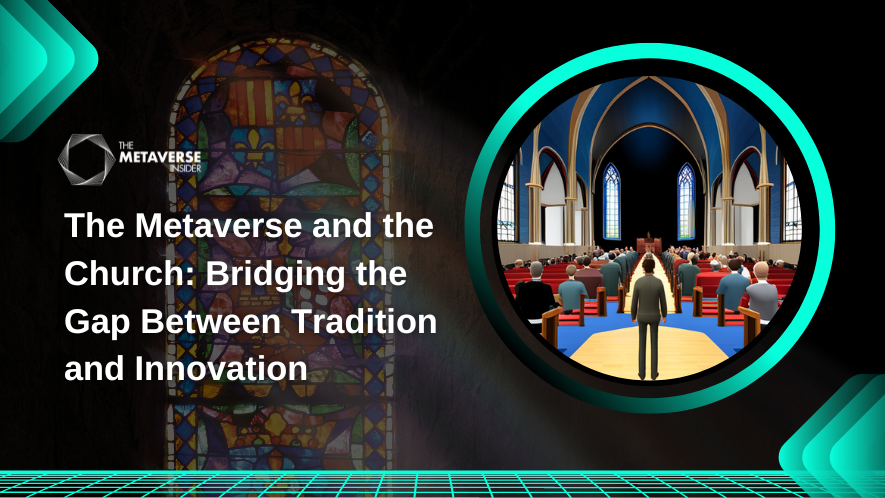In the dynamic and fast-paced era of digital innovation, we cannot ignore the emerging influence of the metaverse – an immersive virtual space where users can interact with computer-generated environments and other users. This increasingly popular phenomenon is not just for gamers or tech enthusiasts; it’s increasingly intersecting with various aspects of our lives, including, quite surprisingly, the sacred and religious realm. There’s a burgeoning interest among some forward-thinking churches to harness the capabilities of the metaverse, hoping to revolutionize the concept of worship and fellowship.
In this ever-evolving digital landscape, the church’s traditional brick-and-mortar confines are being challenged. Through the metaverse, churches are exploring innovative ways to connect with their congregants, delivering immersive worship experiences that transcend geographic limitations and traditional physical interaction. This unique blend of faith and technology could not only reshape the practice of worship but also broaden the reach of the church to a diverse audience.
Join us as we delve into this fascinating topic, examining how the metaverse is beginning to find its place within the sacred halls of the church, and how it might shape the future of worship and faith communities. Whether it’s a digital sermon, a virtual prayer group, or an immersive biblical experience, the metaverse is opening doors to new possibilities in religious practices.
Churches and the Metaverse
In recent years, a transformative shift has occurred in the way we approach work and various other aspects of life. The concept of hybrid working has emerged as a dynamic and adaptable solution that has found its way into every nook and cranny of our daily routines, from our normal working life to even the realm of worship. This phenomenon reflects a fundamental change in the way we perceive and engage with traditional practices, embracing a more flexible and interconnected world.
According to a study conducted by Pushpay, it is evident that many individuals recognize the significance of a hybrid system for worship in the modern era. However, the question arises as to how this recognition extends to metaverse initiatives. The study reveals that 25% of participating church leaders have expressed their intent to provide metaverse experiences within the next 12 months. We sat down with Collin Jones, Chief Ambassador at Pushpay, to learn more about the research, and to better understand emerging technology trends in the church. While the adoption of some of these initiatives continues to evolve, there are already some churches actively exploring the metaverse with their community.
- Life.Church: Pioneering Online Worship
One of the early adopters in this domain was LifeChurch.tv, now known as Life.Church, an evangelical community-based in the United States. They were the first to introduce the concept of a fully internet-based church – taking it to new heights with metaverse-enabled VR experiences. They are known for their application, YouVersion Bible App, which has been downloaded hundreds of millions of times globally.
This revolutionary approach of moving faith-based interactions online paved the way for future developments in the intersection of technology and worship. Since their inception in 1996, they have certainly embraced the digital and virtual technology trends, leveraging themselves to ensure that the medium for worship remains engaging and accessible.
- VR Church: Stepping into the Metaverse
Perhaps the most explicit example of a church in the metaverse is VR Church. Founded in 2016, it claims to be the first church entirely within virtual reality. Services are held in virtual environments, accessible through VR headsets. Congregants, represented by their 3D avatars, can attend weekly services, engage in prayer and worship, and form connections with others. The virtual nature of the church means it is not geographically constrained, allowing it to attract a diverse range of attendees from all over the world.
- The Church of England: Exploring Augmented Reality
The Church of England has also dabbled in emerging technology, with the development of an immersive app that brings to life the stories of churches across the UK. The interactive app offers a rich multimedia experience, merging the physical and digital worlds to deepen engagement and enhance learning. This represents a significant step towards the incorporation of advanced tech in religious experiences.
In 2017, The Church of England launched an initiative called “A Church Near You,” aiming to help people connect with their local churches. As part of this initiative, they developed 360-degree virtual tours feature to allow people to explore the interiors of participating churches from their own homes. This initiative illustrates the Church’s willingness to experiment with immersive digital technologies.
These examples demonstrate how churches are already harnessing emerging technologies to adapt to a changing world. As the metaverse continues to develop, we can expect to see a broader range of faith-based organizations exploring this space, offering immersive and personalized worship experiences that transcend traditional physical limitations.
Digital Renaissance: The Tech-Forward Trend in Worship and its Challenges
As we dive deeper into the 21st century, the broader trend of incorporating technology into worship services is becoming more apparent. It’s not just emerging technologies – churches are leveraging live streams, social media, mobile apps, and even artificial intelligence to engage with their congregations and enrich their worship experiences. These technologies provide avenues for churches to extend their reach, offer more accessible worship options, and even provide additional resources for spiritual growth.
This digital renaissance within the church isn’t without its share of concerns and criticisms. Some worry about the potential for technology to act as a distraction during worship. The simplicity and focus inherent in traditional worship might be disturbed by the bells and whistles of technology, detracting from the sacredness of the experience. Here are some insightful statistics from the Pushpay study conducted on over 2,200 church leaders across the United States:
Limited Budget for Technology: With 58% of the leaders stating that less than 10% of their annual budget is allocated for tech, it’s evident that financial resources for technology integration in church activities are rather limited. This may imply that technology is not perceived as a primary need or investment area in the current church environment.
Limited Interest in Additional Digital Tools: The fact that 86% of the participants aren’t interested in increasing the number of digital tools suggests a potential lack of perceived need, a possible unfamiliarity with such tools, or satisfaction with the current level of technology used. It could also reflect concerns about the costs associated with new tools or the challenges in implementing and managing them.
Mixed Attitudes Towards Technology: The figures of 53% being progressive, 40% being reactionary, and 7% being resistant to the idea of using technology highlight diverse attitudes. The majority, albeit a small one, seems open to incorporating more technology, which signals the potential for future adoption. However, a sizable minority is either reactionary or resistant, indicating apprehension or conservatism in embracing technology.
Cost and Resistance to Change: Finally, when asked what the three main obstacles were to adopting new technology at church, the data points out that ‘cost’ (65%), ‘implementation’ (42%), ‘time’ (42%), and ‘knowledge’ (37%), were the main obstacles to adopting new technology. These findings shed light on a prevailing issue encountered by numerous organizations—a constant struggle between the imperative to embrace innovation and the practical limitations imposed by budgetary constraints and change management processes.
Based on these findings, it seems that while there is some openness towards the use of technology in churches, financial constraints and resistance to change stand as significant obstacles. Many leaders are currently not interested in expanding their digital toolkits, although there is a noticeable fraction that is progressive about the use of technology.
For effective technology adoption in this context, it may be necessary to focus on solutions that are cost-effective and easy to implement. In addition, initiatives to educate church leaders about the benefits of technology, both in terms of enhanced administrative efficiency and enriched community engagement, could help to increase the perceived value of these investments and thereby potentially foster a more tech-forward culture within the church community.
There are also those who question whether digital interactions can truly replace the depth and quality of face-to-face fellowship. In a world already wrestling with the impact of screen time on relationships, the concern that digital worship might contribute to feelings of isolation or disconnection is not unfounded.
However, proponents argue that the goal of incorporating technology isn’t to replace traditional worship but to enhance and supplement it. Just as churches throughout history have used the technology of their time – from the printing press to broadcast radio, today’s digital tools are seen to continue the church’s mission in a rapidly changing world.
Moreover, advocates for these tech-forward trends underline the potential for inclusivity that technology brings to the table. For those unable to attend physical services due to health, distance, or other personal circumstances, digital options can provide a lifeline to communal worship and spiritual nourishment.
As we continue into the future, finding the balance between tradition and innovation will be key. It’s a complex conversation, filled with potential and fraught with challenges, but one that must be had as we navigate the intersection of faith and technology in this evolving digital landscape.
Beyond Traditional Boundaries of Worship
As the conversation around the use of the metaverse in worship unfolds, there is growing recognition of its potential to attract individuals who might not otherwise engage with traditional forms of worship. The appeal of the metaverse lies not only in its novelty but also in its capacity for inclusivity and accessibility. By providing diverse, personalized experiences, it has the potential to cater to an array of people, transcending the barriers often associated with traditional forms of worship.
For instance, consider the younger generation – millennials and Gen Z, who are digital natives and often perceive traditional church services as antiquated. The metaverse can provide a bridge, incorporating elements that resonate with them, such as interactive multimedia, gamified bible studies, or social networking opportunities within a faith-based community.
Similarly, for individuals with physical disabilities or health conditions that prevent them from attending traditional church services, the metaverse could offer an alternative way to participate in communal worship. From the comfort of their homes, they could attend virtual sermons, engage in prayer groups, or even have spiritual conversations with other avatars in the digital realm.
The metaverse also has the potential to revolutionize the concept of religious pilgrimage. For example, Christians for whom a physical journey to the Holy Land might not be feasible could embark on a virtual reality pilgrimage, “walking” the Via Dolorosa or exploring the Church of the Holy Sepulchre in Jerusalem. This would make these profound religious experiences more accessible to a broader range of people.
Furthermore, the metaverse could foster interfaith understanding and dialogue. Virtual reality churches could hold joint worship services with other faith groups, providing an immersive experience of different religious practices. This would not only increase exposure to various faith traditions but could also promote empathy and understanding in an increasingly diverse and pluralistic world.
For instance, those with unconventional beliefs, or people simply exploring their spirituality in a non-traditional way, could find a welcoming community in the metaverse, where they can explore faith on their own terms.
Of course, some of these examples are hypothetical and the use of the metaverse in worship is still in its nascent stage. However, as this digital frontier continues to evolve, the possibilities for creating more inclusive and accessible worship experiences will likely expand, potentially transforming the landscape of faith in the 21st century.
The Future of the Metaverse in Worship
In conclusion, we stand on the cusp of a significant shift in the religious landscape, propelled by technological advancements like the metaverse. From the pioneering efforts of faith-based organizations like Life.Church, VR Church, and the Church of England, we’re beginning to see the transformative potential of these digital frontiers in enhancing worship experiences and fostering inclusivity.
However, it’s essential to navigate these new territories with care, addressing potential concerns about the intersection of faith and technology. Striking a balance between tradition and innovation, between the sacredness of worship and the allure of technology, will be crucial in shaping the future of religious practice.
Looking ahead, we can envision a metaverse that hosts VR pilgrimages, fosters interfaith dialogue, and provides a safe space for diverse individuals to explore faith on their terms. This potential to democratize access to religious experiences opens exciting possibilities for the future of worship.
As we move forward, we encourage readers to consider how these emerging tech trends might be applied within their own social circles. The investigation of technology’s role in society is not only for a small group but presents a chance for everyone to participate in the ongoing conversation about human interaction in the digital era. Indeed, the future of societal cohesion is a common responsibility, and together, we can mold it in a way that resonates with our collective values of inclusivity, connectivity, and personal development.



















